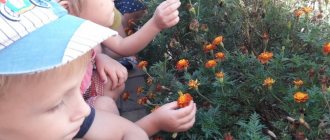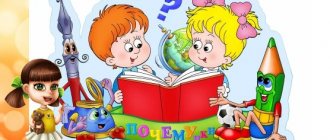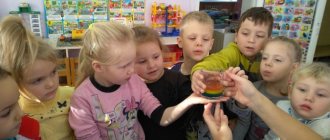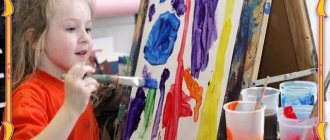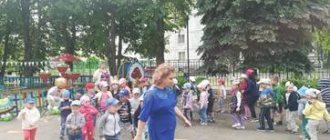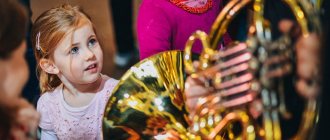Artistic and speech activities of children in kindergarten
The spiritual life of a child is complete only when he lives in the world of fairy tales, creativity, imagination, and fantasy. And without this he is a dried flower
V. Sukhomlinsky
The methodological basis for the development and implementation of the Federal State Educational Standard for Preschool Education was the Concept of Spiritual and Moral Development and Personality Education of a Russian Citizen. Art plays a major role in achieving this task. The life of a child takes place in the world of art in all its diversity and richness. Here the spiritual work of the individual takes place, and the main task is to grow and comprehend national consciousness. To do this, notes G. P. Fedotov, “we must know the history of Russia, love its heroes, appreciate monuments, know literature, the life of its peoples, their work, their art, their beliefs and way of life.” The thoughts expressed by the philosopher make us think about the ways of formation the child has national identity.
One of the important sources of development of a child’s spiritual principles is the formation of creative abilities. This is facilitated by play - dramatization, staging of literary texts, through the use of different types of theater (tabletop, finger, puppets, parsley, etc.), and then inventing your own literary works and their embodiment in theatrical games.
Creativity is an independent activity that leads to the development of artistic abilities, the formation of requests and interests. To teach creativity, it is necessary to enrich a person’s thinking with already known materials.
The formation of verbal creativity skills in children occurs on the basis of the combining action of imagination, which allows the child to use familiar images, words, and expressions. In combination, it is something new, creative, belonging to the child.
Independent artistic activity involves:
− the emergence of an artistic concept as a manifestation of the child’s interests, dictated by early motives, conditioned by experience;
− implementation of a plan, the quality of which depends on mastering the method of transferring existing experience;
− self-control of actions.
Considering a child’s verbal creativity as the initial stage of his literary development, we believe that only a well-developed skill, mastered skills of verbal creativity can in the future become the basis for elementary verbal creativity. That is why it is necessary to teach the native language to preschool children and create conditions for the development of independent artistic and speech activity.
Artistic creativity is a process of cognition and figurative reflection of reality, manifested in selection, in the enrichment of certain life phenomena in an individually unique form of their embodiment (N. A. Vetlugina)
The main conditions for the formation of artistic activity are:
− artistic training of the teacher;
− organization of a subject environment in order to create an environment for children to realize their creative ideas (mummering corner, masks, different types of theater, book corner, selected illustrations, paintings, etc.).
− training, which involves expanding knowledge about the world around us, developing skills and abilities;
− meaningful life of a child in kindergarten (holidays, entertainment, etc.).
Let us dwell on some highlighted conditions.
Training - as a pedagogical condition for the formation of artistic activity - is aimed at the child’s assimilation of experience, at the formation of methods, actions, at the development of his artistic abilities.
When familiarizing children of early preschool age with the material, the teacher’s explanatory and illustrative methods and the child’s corresponding performing and reproductive methods dominate. Later, the teacher resorts to using the explanatory-motivating method, and the child – to the independent-search method of action. (N.A. Vetlugina).
Since no single method is universal; it is necessary to combine methods that rely on children’s independent actions and methods of precise instructions and showing standards of action.
The method of precise instructions and showing standards of action is used where children need to be taught to accurately reproduce a given example. For example, it is necessary to accurately reproduce the words of the text, expressively reproduce a phrase, a word.
The method of developing methods of independent action is used where the child needs to find a method of execution, introduce a new option, control the quality of his actions with hearing, vision. Actions are independent and creative, the child can use what was shown to him earlier; following the standard, he looks for adequate techniques using self-control.
In the learning process, it is necessary to pay attention to the selection of literary material that is easily absorbed by all children and captivates them with the topic. The use of dolls in the classroom allows the child to successfully use them in independent activities. Teaching methods of independent activity ensures such activity in theatrical games and artistic activity in general. This in turn encourages self-learning and mutual assistance.
N.A. Vetlugina, L. Furmina recommend that when teaching, create a special holiday atmosphere in a group (costumes, fragments of decoration, instruments), draw up scripts for holidays, and then, together with the children, come up with your own entertainment programs and theatrical performances.
Particular attention should be paid to preparing children for independent artistic activity through working with fiction with the aim of using it in dramatization and performances. This is the main way of forming creative speech activity is revealed in modern pedagogical literature. However, practice shows that there is an urgent need to teach children creative storytelling using elements of puppeteering in order to increase the level of organization of independent artistic activity.
Using creative storytelling in teaching children, we assumed that in order to develop a high level of artistic and speech activity in preschoolers, it is necessary to develop the ability to invent stories and fairy tales. This work is mainly carried out in speech development classes. In practice and methodological writing, most often oral creative compositions are not associated with children’s theatrical games. The formation of creative imagination and thinking suggests the development of a certain level of improvisation in them, drawing up their own scripts for theatrical productions. Therefore, during creative storytelling classes, all children were taught puppeteering techniques. The characters learned to drive gradually. We started work by driving three-dimensional table theater puppets (a couple of dolls for each table, the height of the toys was from 10–20 cm, so that the child could hold them comfortably). After four or five lessons, tabletop flat toys were brought in (two per table). Children consolidated their ability to work with a toy: the figure walks, runs, speaks, and leans slightly forward or to the side. During the work, attention was paid to ensuring that while pronouncing words behind the figurine, the child moved it depending on the text. Children's training began with pronouncing one phrase for the hero in combination with the corresponding movement, then the volume of spoken text increased due to the task proposed by the teacher, and then due to the text invented by the child himself. Children were offered songs, rhymes, and text excerpts from fairy tales. This type of theater is given three to four lessons. After this there was a finger theater. The work methodology proposed for the flat theater was repeated. Attention was paid to the technique of driving the doll, the expressiveness of speech, the relationship of words and the movement of the doll. The last to be offered were the parsley theater figurines. Thus, by mastering the specifics of creative stories, the child masters the basic techniques of puppeteering and performs a creative task, which in turn ensures the formation of independent theatrical activity.
To develop your voice and articulatory apparatus, it is recommended to memorize tongue twisters. Use tasks like “the steamer is humming” or “call your girlfriends in the forest.”
It is necessary to teach children to understand the emotional state of another person and convey their own. This is helped by sketches to express attention, fear, joy, pleasure.
It is necessary to develop creative independence. Give great importance to improvisation. For example, the game “Which fairy tale will I show?” Children use pantomime to show a fairy tale without uttering a word. The game “Lullaby” is interesting, where the girls show how the mother puts the baby to sleep (they rocked them, stroked them on the head, while looking at them tenderly like a mother.”
Theatrical activity is a source of development of feelings, experiences, and introduces him to spiritual values.
With the help of a fairy tale, a child learns to distinguish between good and evil, not only in a fairy tale, but also in life. Favorite heroes become role models. But the main thing is to teach a child to survive in this complex world. To teach friendship, mutual understanding, wisdom, and the ability to get out of the current situation with dignity, that is, to find a compromise and the ability to negotiate with each other.
Speaking in front of the audience, children overcome shyness and embarrassment, learning the text, memory and thinking develop. This means that all these qualities will have a beneficial effect on the child’s educational activities at school and will help him feel confident among his peers.
Thus, theatrical activities help to develop the child comprehensively.
Knowledge of indicators of artistic activity enables practitioners to competently realize goals, analyze the artistic activity of preschool children in games and in independent artistic and speech activities.
The formation of artistic and speech abilities of preschool children goes through several stages, each of which is characterized by a certain level of development and manifestation of children’s creative abilities.
− Stage 1 – children learn to perceive and analyze literary works, their content and means of expression.
− Stage 2 - children learn to reproduce a finished literary work. For this purpose, different types of theater are used. Creative independence is manifested through the search for ways to convey expressive means for images, through mastering the technique of puppeteering.
− Stage 3 - characterized by the creation of their own skits for the theater, performance programs and preparation of performances. This is already the stage of independent creative and speech activity.
Thus, the indirect nature of leadership depends on:
a) from a conducive atmosphere (the friendly attitude of an adult, the subject environment);
b) from the presence of common elements in independent artistic speech activity and in the organization of classes, holidays, and entertainment;
c) from the development of special artistic abilities in children through specially organized training (L. V. Voroshina), which will help the teacher competently and effectively manage this type of activity;
d) from the development of the pedagogical abilities of educators, their artistic knowledge, abilities, skills, aesthetic taste and interest in artistic and speech activities.
Literature:
- Genov G.V. Theater for kids. M.: Enlightenment. 1968.
- Ermolaeva - Tomina L. B. The problem of developing children's creative abilities // Questions of psychology. 1975. No. 5.
- Karamanenko T. N. Puppet theater in kindergarten. M.: Uchpedgiz, 1960.
Language acquisition is the most important task of preschool education. Its relevance is especially great in our time, when there is a widespread decline in culture. We must begin this work as early as possible, otherwise it will be difficult for our children to become successful in adulthood.
The main task of developing figurative speech is to instill in children a love for the literary word and respect for the book; introduce those works of fiction that children need to read, tell, and memorize.
At the present stage, artistic and speech activity is considered not only as a means of developing expressiveness and figurative speech, but also as a means of developing children’s creative abilities.
Therefore, while working on the topic of creative search “Artistic and speech activity of a preschooler,” I solve problems in the formation of artistic and speech activity as one of the integral parts of the aesthetic education of children.
I believe that the most important sources for the development of expressiveness of children's speech are works of fiction and oral folk art, including small folklore forms (proverbs, sayings, riddles, nursery rhymes, counting rhymes, phraseological units).
When introducing works of fiction, I try to give children an idea of the features of the genre, reveal the ideological and artistic meaning of the work, and show the beauty and poetry of the images and language.
My practice of working on this topic shows that through organized educational activities, children acquire a certain amount of skills and abilities in artistic and speech activities.
Therefore, for this purpose, I read and tell fairy tales and stories to children, learn poems with them, teach them how to elementary analyze texts, retell and dramatize short literary works, inventing my own short fairy tales, stories, riddles in order to
induce in children a desire to use the acquired knowledge in everyday life.
However, my observations show that preschoolers are not always able to independently engage in artistic and speech activities. Therefore, I use the time free from classes in the afternoon on the topic of my creative research on the artistic and speech activities of children.
In order to expand and consolidate children's knowledge about books, I created and decorated a special area in the group room in which children can leaf through books they know, look at the illustrations in them, listen to fairy tales recorded on gramophone records, cassettes, disks, and retell what they have read to their friends using theater of toys, shadows, puppets, flannelograph, play literary games, prepare for holiday matinees, evenings of entertainment.
And organizing excursions to a bookstore, a children's library, or a city library for adults will intensify the children's activities in the book corner.
To generalize and consolidate knowledge on the topic of creative search, I conduct literary entertainment, such as: “Books are our friends,” Visiting the Queen of Literature.”
My children, in their free time from classes, being impressed by the literary works they listened to (fairy tales, short stories, poems), recreate the images they liked in drawing, appliqué or modeling.
I believe that the main goal when organizing literary games is to develop children’s artistic taste, imagination and creative thinking, and the formation of coherent speech. Together with the children, I organize the following literary games: “Let’s draw a fairy tale,” “Come up with a story, a fairy tale based on a drawing (or a picture), “Tell a fairy tale based on pictures,” and others.
Gradually, as the child develops the necessary skills and abilities and acquires the necessary knowledge, my role becomes secondary, because I give the children more freedom, and I only help them in cases where they find it difficult in some way.
I place all the children’s drawings and writings in an album of children’s creativity. This could be a baby book for an individual child, an album in which stories, fairy tales, poems, and riddles invented by children will find a place.
At the end of the school year, I organize an exhibition of children's creativity and hold a joint conference of educators, parents, and primary school teachers.
The interconnected components of artistic and speech activity of preschoolers are not only the perception of a literary text, its reproduction (reproduction), but also elementary verbal creativity.
I develop verbal creativity in children by inventing riddles, writing fairy tales and stories. Children themselves find visual means, comparisons, epithets, come up with the composition of fairy tales, stories (beginning, main part, ending), choose images of characters and show them on a flannelgraph or use a flat tabletop theater.
Play-dramatization is the most accessible and interesting way for a child to process and express impressions, knowledge and emotions and at the same time an effective means of understanding the subtext of a literary or folklore work. This method of conveying a fairy tale or story is most popular among older preschoolers. It allows children to learn how to correctly construct dialogues and monologues, describe phenomena and objects.
Artistic and speech development contributes to the development of children’s creative and intellectual abilities and their speech culture, the formation of an emotionally positive attitude towards the world around them in preschoolers, and contributes to the formation of artistic and speech activity.
Thus, a competent approach of teachers when organizing artistic and speech activities contributes to the development of not only speech skills, but also the creative abilities of children.
MAGAZINE Preschooler.RF
Outline plan for conducting independent artistic activities (theater-speech, visual, musical) for pupils in the afternoon in the senior group. Author of the development: Voinova Irina Petrovna, teacher of the first category, MBDOU TsRR kindergarten No. 282 Program content: - promote independent organization of the game in “theater”; - continue to teach how to convey the text of a fairy tale sequentially; - use in speech expressive means characteristic of Russian folk tales (beginning, repetitions, songs of characters, etc.); - take initiative in decorating the scenery for the theater (painting fairy-tale houses, trees, bushes, berries); - on their own initiative, students select the simplest melodies on musical instruments; -nurture creative abilities. Organization of independent artistic activities Prepare material for visual activities (brushes, gouache, watercolor, natural material). Prepare equipment for musical activities Prepare materials and equipment for theatrical and speech activities (puppets, screen for a puppet theater, tickets for the theater, box office for selling tickets, cardboard for making scenery). Course of theatrical and speech activity Educator: Guys, you and I have gone to the theater more than once, watched performances and puppet theaters there. Who do you think presents us with the opportunity to watch performances? (Children's answers). That's right, these are the people who work in the theater. Let's remember what professions we met while visiting the theater? (Children's answers). Who can tell me what artists do in the theater? (Children's answers). What is a cashier needed for? (Children's answers). What is the duty of ticket takers? (Children's answers). Would you like to organize your own theater? The guys in our group have prepared a small performance for you, but do they need helpers: ticket takers, a cashier, artists to decorate the scenery and prepare the stage for the performance? Who wants to help them? Who will be our artists, cashier, ticket takers? (Selection of children for these roles) And the rest of the children will be spectators. Before the performance we have time, and so that the audience does not get bored, I prepared everything they need so that they can draw their favorite fairy tale or make a fairy-tale hero from natural material. At the end of the performance, we will arrange an exhibition: “My favorite fairy-tale hero.” But before we each start doing our own activities, I want to know if you know the rules of conduct in a theater or other public place. Who wants to tell them? (Children's answers). And now all the guys calmly begin their duties. After the invitation, when the theater workers have everything ready, we will buy tickets and go into the auditorium. The children go to their places: the audience is engaged in visual and musical activities, the artists are preparing the puppets, the auditorium, the artists are decorating the stage, the cashier is preparing his future workplace, and the ticket takers are helping to prepare the auditorium. At the end of all this work, Parsley appears. Parsley: Whoever doesn’t believe it, let him check, I’m glad to have any guest. I open the doors to the fairy tale, invite all the children (Children go to buy tickets and take seats in the hall. Make sure that tall children sit in the back seats, and little ones and girls sit in front) Presenter: The fairy tale is rich in wisdom, Let's tell the fairy tale to come. This is a saying, guys, The fairy tale will be ahead Russian folk tale “The Snow Maiden and the Fox” (Puppet theater performance by children). At the end, the teacher asks the children if you liked the fairy tale, Which character did you like best? What were the fox, bear, wolf, and Snow Maiden in the fairy tale? Now let's look at the work you, the audience, did before the performance. (Review and short analysis of works). Based on your work, it turned out that these are your favorite fairy-tale characters, next time we will stage another performance with you.| Next > |
